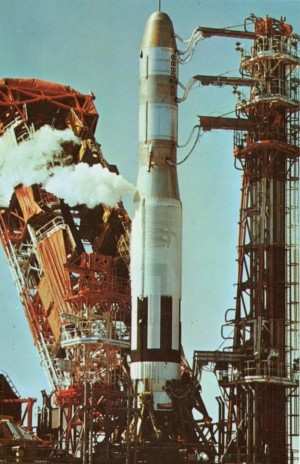Using A Method Developed 50 Years Ago, NASA Aims Toward The
Future.
By Wes Oleszewski
Waiting, fully assembled on its Mobile Launch Platform, the Ares
I-X flight development vehicle carries forward a form of flight
testing that was used in the early days of launch vehicle
evolution.

Ares I-X Assembled
Consisting of a single, four segment Space Shuttle SRB plus a
fifth segment simulator, a dummy upper stage, a spacecraft mock-up
and a dummy Launch Abort System the Ares I-X is designed to
validate computer modeling and gather data on suppositional issues
such as bending moments, thrust oscillation and drift at liftoff.
Testing of this kind has its roots in early projects such as the
Titan I ICBM, Mercury Redstone and Saturn I.
Prior to the "All-Up" testing method that, was first implemented
in the Minuteman ICBM, the standard for development of launch
vehicles was the step-by-step method. In that method, every aspect
of a vehicle's lower stages had to be well understood before adding
the next stage. One of the best examples of the testing with dummy
upper stages was the Titan I, Lot A, vehicles that began flying on
February 6, 1959. The four Lot-A Titan I vehicles all had dummy
upper stages that had little resemblance to the operational upper
stages, yet valued data and handling procedures were gained by
those flights.

Lot A Titan Photo Courtesy
USAF
In the summer of 1961 that first Saturn I launch vehicle was
stacked at Launch Complex 34 and launched in late October of that
year. This "Block I" launcher carried two dummy upper stages filled
with water to simulate fuel. The first four Saturn I vehicles
differed greatly from the Block II launchers that, at the time,
were intended for manned flight. The Block I vehicles had no fins,
a different adapter skirt, no Instrument Unit and no Apollo
spacecraft or escape tower. Additionally, the Block I vehicle's
fuel and LOX tanks were approximately six feet shorter than the
Block II. Although the Block I Saturns bore little
resemblance to the planned Block II and even less resemblance to
the later Saturn IB, which actually did carry astronauts into
space, the Block I launchers and their dummy upper stages provided
valuable data and revealed equipment flaws that provided the
Apollo moon program with a solid foundation on which to build.
Perhaps the most often overlooked launcher with a dummy payload
is the MRBD, or the Mercury Redstone Booster Development flight.
This flight was the result of 11 glitches that showed up in the
final Mercury Redstone "Chimp" flight. The MRBD was inserted
into the schedule to prove out fixes that were made with the launch
vehicle prior to committing a man to its use. The flight used a
dummy Mercury capsule leftover from the Little Joe 1B flight and
dummy escape tower, yet it cleared the way for Alan Shepard's
Freedom 7 flight.

Saturn SA-1 Photo Courtesy
NASA
Currently the Ares I-X vehicle waits to have its turn at making
the first step in the step-by-step testing of the next generation
of standard United States manned launch vehicles. Having stepped
away from the desperation of the old "space race," and the accepted
risk of all-up testing, NASA now has the benefit of time and the
ability to use greater care in how the new generation of human
spaceflight boosters are developed. Although the Ares I-X may not
fully resemble the final launch vehicle in some ways, its benefits
will be great. The launch date for the Ares I-X has been set for
October 27, 2009, which is the 49th anniversary of the launching of
the first Saturn I, SA-1. As the Ares I-X prepares to launch, the
arm-chair critics claim that it will shake, drift and perhaps fold
in half and explode and they often refer to it as "The world's
largest model rocket." Thus it is interesting to note that these
same sort of comments were made 49 years ago, when SA-1 was called
"Cluster's last stand" implying that the cluster concept would
shake, drift and explode. Instead- SA-1 led mankind to the
moon.
 ANN's Daily Aero-Linx (04.16.24)
ANN's Daily Aero-Linx (04.16.24) Aero-News: Quote of the Day (04.16.24)
Aero-News: Quote of the Day (04.16.24) Airborne 04.10.24: SnF24!, A50 Heritage Reveal, HeliCycle!, Montaer MC-01
Airborne 04.10.24: SnF24!, A50 Heritage Reveal, HeliCycle!, Montaer MC-01 Airborne 04.12.24: SnF24!, G100UL Is Here, Holy Micro, Plane Tags
Airborne 04.12.24: SnF24!, G100UL Is Here, Holy Micro, Plane Tags Airborne-Flight Training 04.17.24: Feds Need Controllers, Spirit Delay, Redbird
Airborne-Flight Training 04.17.24: Feds Need Controllers, Spirit Delay, Redbird





